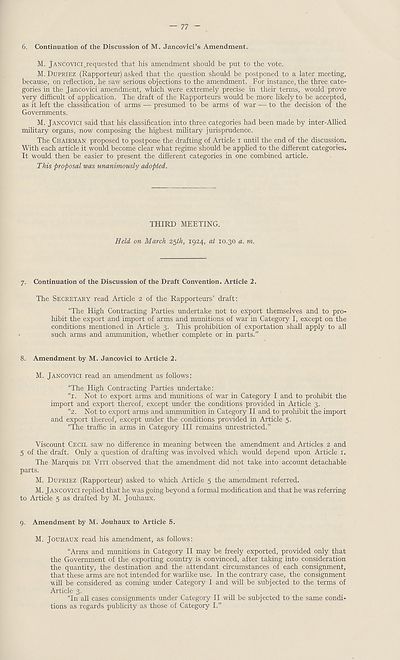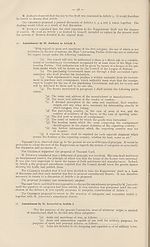Armament > Conference for the control of the international trade in arms, munitions and implements of war
(79)
Download files
Complete book:
Individual page:
Thumbnail gallery: Grid view | List view

— 77
6. Continuation of the Discussion of M. Jancovici’s Amendment.
M. Jancovici .requested that his amendment should be put to the vote.
M. Dupriez (Rapporteur) asked that the question should be postponed to a later meeting,
because, on reflection, he saw serious objections to the amendment. For instance, the three cate¬
gories in the Jancovici amendment, which were extremely precise in their terms, would prove
very difficult of application. The draft of the Rapporteurs would be more likely to be accepted,
as it left the classification of arms — presumed to be arms of war — to the decision of the
Governments.
M. Jancovici said that his classification into three categories had been made by inter-Allied
military organs, now composing the highest military jurisprudence.
The Chairman proposed to postpone the drafting of Article i until the end of the discussion.
With each article it would become clear what regime should be applied to the different categories.
It would then be easier to present the different categories in one combined article.
This 'proposal was unanimously adopted.
THIRD MEETING.
Held on March 25th, 1924, at 10.30 a. m.
7. Continuation of the Discussion of the Draft Convention. Article 2.
The Secretary read Article 2 of the Rapporteurs’ draft:
“The High Contracting Parties undertake not to export themselves and to pro¬
hibit the export and import of arms and munitions of war in Category I, except on the
conditions mentioned in Article 3. This prohibition of exportation shall apply to all
such arms and ammunition, whether complete or in parts.”
8. Amendment by M. Jancovici to Article 2.
M. Jancovici read an amendment as follows:
“The High Contracting Parties undertake:
“1. Not to export arms and munitions of war in Category I and to prohibit the
import and export thereof, except under the conditions provided in Article 3.
“2. Not to export arms and ammunition in Category II and to prohibit the import
and export thereof, except under the conditions provided in Article 5.
“The traffic in arms in Category III remains unrestricted.”
Viscount Cecil saw no difference in meaning between the amendment and Articles 2 and
5 of the draft. Only a question of drafting was involved which would depend upon Article 1.
The Marquis de Viti observed that the amendment did not take into account detachable
parts.
M. Dupriez (Rapporteur) asked to which Article 5 the amendment referred.
M. Jancovici replied that he was going beyond a formal modification and that he was referring
to Article 5 as drafted by M. Jouhaux.
9. Amendment by M. Jouhaux to Article 5.
M. Jouhaux read his amendment, as follows:
“Arms and munitions in Category II may be freely exported, provided only that
the Government of the exporting country is convinced, after taking into consideration
the quantity, the destination and the attendant circumstances of each consignment,
that these arms are not intended for warlike use. In the contrary case, the consignment
vill be considered as coming under Category I and will be subjected to the terms of
Article 3.
“In all cases consignments under Category II will be subjected to the same condi¬
tions as regards publicity as those of Category I.”
6. Continuation of the Discussion of M. Jancovici’s Amendment.
M. Jancovici .requested that his amendment should be put to the vote.
M. Dupriez (Rapporteur) asked that the question should be postponed to a later meeting,
because, on reflection, he saw serious objections to the amendment. For instance, the three cate¬
gories in the Jancovici amendment, which were extremely precise in their terms, would prove
very difficult of application. The draft of the Rapporteurs would be more likely to be accepted,
as it left the classification of arms — presumed to be arms of war — to the decision of the
Governments.
M. Jancovici said that his classification into three categories had been made by inter-Allied
military organs, now composing the highest military jurisprudence.
The Chairman proposed to postpone the drafting of Article i until the end of the discussion.
With each article it would become clear what regime should be applied to the different categories.
It would then be easier to present the different categories in one combined article.
This 'proposal was unanimously adopted.
THIRD MEETING.
Held on March 25th, 1924, at 10.30 a. m.
7. Continuation of the Discussion of the Draft Convention. Article 2.
The Secretary read Article 2 of the Rapporteurs’ draft:
“The High Contracting Parties undertake not to export themselves and to pro¬
hibit the export and import of arms and munitions of war in Category I, except on the
conditions mentioned in Article 3. This prohibition of exportation shall apply to all
such arms and ammunition, whether complete or in parts.”
8. Amendment by M. Jancovici to Article 2.
M. Jancovici read an amendment as follows:
“The High Contracting Parties undertake:
“1. Not to export arms and munitions of war in Category I and to prohibit the
import and export thereof, except under the conditions provided in Article 3.
“2. Not to export arms and ammunition in Category II and to prohibit the import
and export thereof, except under the conditions provided in Article 5.
“The traffic in arms in Category III remains unrestricted.”
Viscount Cecil saw no difference in meaning between the amendment and Articles 2 and
5 of the draft. Only a question of drafting was involved which would depend upon Article 1.
The Marquis de Viti observed that the amendment did not take into account detachable
parts.
M. Dupriez (Rapporteur) asked to which Article 5 the amendment referred.
M. Jancovici replied that he was going beyond a formal modification and that he was referring
to Article 5 as drafted by M. Jouhaux.
9. Amendment by M. Jouhaux to Article 5.
M. Jouhaux read his amendment, as follows:
“Arms and munitions in Category II may be freely exported, provided only that
the Government of the exporting country is convinced, after taking into consideration
the quantity, the destination and the attendant circumstances of each consignment,
that these arms are not intended for warlike use. In the contrary case, the consignment
vill be considered as coming under Category I and will be subjected to the terms of
Article 3.
“In all cases consignments under Category II will be subjected to the same condi¬
tions as regards publicity as those of Category I.”
Set display mode to:
![]() Universal Viewer |
Universal Viewer | ![]() Mirador |
Large image | Transcription
Mirador |
Large image | Transcription
Images and transcriptions on this page, including medium image downloads, may be used under the Creative Commons Attribution 4.0 International Licence unless otherwise stated. ![]()
| League of Nations > Armament > Conference for the control of the international trade in arms, munitions and implements of war > (79) |
|---|
| Permanent URL | https://digital.nls.uk/195382790 |
|---|
| Shelfmark | LN.IX |
|---|
| Description | Over 1,200 documents from the non-political organs of the League of Nations that dealt with health, disarmament, economic and financial matters for the duration of the League (1919-1945). Also online are statistical bulletins, essential facts, and an overview of the League by the first Secretary General, Sir Eric Drummond. These items are part of the Official Publications collection at the National Library of Scotland. |
|---|---|
| Additional NLS resources: |
|

